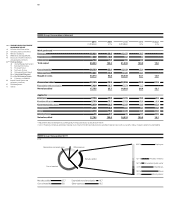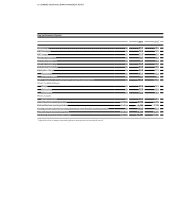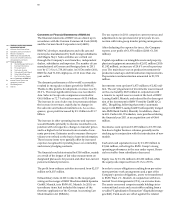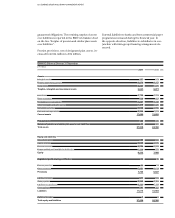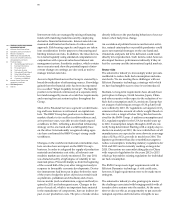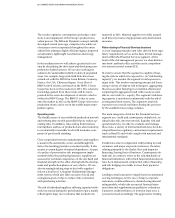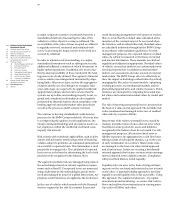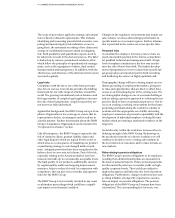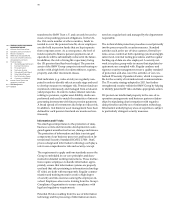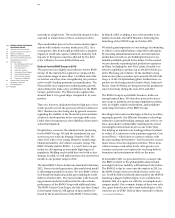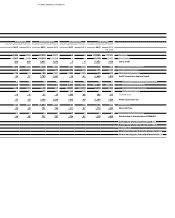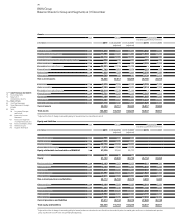BMW 2011 Annual Report Download - page 68
Download and view the complete annual report
Please find page 68 of the 2011 BMW annual report below. You can navigate through the pages in the report by either clicking on the pages listed below, or by using the keyword search tool below to find specific information within the annual report.
68
18 COMBINED GROUP AND COMPANY
MANAGEMENT REPORT
18 A Review of the Financial Year
20 General Economic Environment
24 Review of Operations
43 BMW Stock and Capital Market
46 Disclosures relevant for takeovers
and explanatory comments
49 Financial Analysis
49 Internal Management System
51 Earnings Performance
53 Financial Position
56 Net Assets Position
59 Subsequent Events Report
59 Value Added Statement
61 Key Performance Figures
62 Comments on BMW AG
66 Internal Control System and
explanatory comments
67 Risk Management
73 Outlook
Interest-rate risks are managed by raising refinancing
funds with matching maturities and by employing
derivative financial instruments. Interest-rate risks are
measured and limited on the basis of a value-at-risk
approach. Risk-bearing
capacity and targets are taken
into consideration for
the purposes of measuring and
limiting interest rate
risks. In addition, the risk-return ra-
tio is tested regularly
using simulated computations in
conjunction with a
present-value-based interest rate
management system. Sensitivity
analyses, which contain
stress scenarios and show the
potential impact of inter-
est-rate changes on earnings,
are also used as tools to
manage interest-rate risks.
Access to liquid funds across the Group is ensured by a
broad diversification of refinancing sources. Knowledge
gained from the financial crisis has been incorporated
in a so-called “Target Liquidity Concept”. The liquidity
position is monitored continuously at a separate entity
level and managed by means of a cash flow requirements
and sourcing forecast system in place throughout the
Group.
Most of the Financial Services segment’s credit financ-
ing and lease business is refinanced on capital mar-
kets. The BMW Group has good access to financial
markets thanks to its excellent creditworthiness and,
as in pre vious years, was able to raise funds at good
conditions in 2011, reflecting a diversified refinancing
strategy on the one hand and a solid liquidity base
on the other. Internationally recognised rating agen-
cies have confirmed the BMW Group’s strong credit-
worthiness.
Changes on the world's international commodities
mar-
kets can also have an impact on the BMW Group’s
busi
ness. In order to safeguard the supply of production
materials and minimise cost risks, all relevant com-
modities markets are closely monitored. The year 2011
was characterised by a high degree of volatility in raw
materials prices. Prices fell sharply as from the beginning
of the second half of the year, after rising previously in
response to favourable economic developments. Deriva-
tive instruments had been put in place before the start
of the year to hedge the prices of precious metals (such
as platinum, palladium and rhodium) and of non-
ferrous metals (such as aluminium, copper and lead)
re-
quired in 2011 and subsequent years. Changes in the
price of crude oil, which is an important basic material
in the manufacture of components, have an indirect im-
pact on our production costs. The price of crude oil also
directly influences the purchasing behaviour of our cus-
tomers when fuel prices change.
An escalation of political tensions and terrorist activi-
ties, natural catastrophes or possible pandemics could
cause raw material shortages on the one hand and,
if mate rials and parts fail to be delivered, could result
directly in lost production. Such factors could, however,
also impact business performance indirectly if they af-
fect the economy and the international capital markets.
Sector risks
The automotive industry is increasingly under pressure
worldwide to reduce both fuel consumption and emis-
sion levels. We are meeting these challenges with our
Efficient Dynamics technology, a strategy with which
we have had tangible success since it was introduced.
Medium- to long-term requirements have already been
put in place in Europe, North America, Japan, China
and other countries with respect to the reduction of ve-
hicle fuel consumption and CO2 emissions. Europe has
set a target of achieving an average of 130 g / km for all
new vehicles by 2015. EU regulations set targets for CO2
emissions that take account of vehicle weight. Based on
the new rules, a target of below 140 g / km has been de-
rived for the BMW Group. A uniform consumption and
CO2 regulation applies in the USA for model years up
to 2016. Consumption targets through to 2025 are cur-
rently being determined. Starting with a step-by-step re-
duction in model year 2012, the new vehicle fleets of all
manufacturers are expected to come down to an average
value of 250 g of CO2 per mile in model year 2016. The
Japanese government has also set ambitious targets to
reduce consumption, including statutory regulations for
2010 and 2015 and is currently working on targets for
2020. Discussions are currently taking place in China
with respect to legislation for the years 2012 to 2015
which
go beyond the existing regulations for individual
car fuel consumption.
The BMW Group meets legal requirements with its
Efficient Dynamics technology. A risk could arise,
however, if legal requirements were to be made more
stringent.
The automotive industry is also gearing up to master
the challenges associated with bringing models with al-
ternative drive systems onto the market. At the same
time we also see this as an opportunity to put our
tech-
nological expertise and innovative strengths to use.




